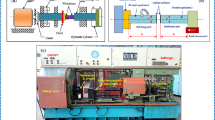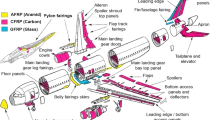Abstract
Threaded shafts are widely used in modern mechanical equipment as fasteners or transmission parts. Thread cold rolling process with round dies is an efficient way to manufacture threaded shaft due to wide dimension range of the threaded shaft, simple structure of rolling die, and convenient adjustment of rolling process. In this paper, a full three-dimensional finite element model of thread cold rolling process with round dies was developed by comprehensive considering the calculation efficiency and precision, and the forming characteristics of the thread cold rolling process with round dies were studied by using numerical method. The results indicated that the metal flow and plastic deformation mainly occur in the superficial area near the thread profile; and the radial load is the main load of rolling dies, which increases with the increase of radial infeed of rolling dies and decreases gradually after the stop of radial infeed; and the characteristics of metal flow, stress distribution, and strain distribution in the crest, flank, and root of the thread profile are significantly different. The crest areas of the thread profile are mainly formed by radial metal flow, and the flank areas of the thread profile are mainly formed by axial metal flow, and the root areas of the thread profile are mainly formed by radial material flow. The equivalent stress and equivalent strain increase gradually from the crest to the root of the thread profile, and reach their maximum at the root areas of the thread profile. Although the height of the thread profile, strain, and stress in the areas near both ends of the threaded shaft is lower than that in the middle zone of shaft, the profile of the thread, strain, and stress distribute periodically as fluctuation of peaks and valleys along axial direction (i.e., x-axis). However, the peak and valley of the strain (or stress)-x curve are opposite with the crest and root of the thread profile. The metal flow and deformation along axial direction present a short-range effect, which would mainly affect the forming of the adjacent thread profiles, and have little effect on the other thread profiles.














Similar content being viewed by others
Availability of data
Data supporting results are included in this article.
References
Tschätsch H (2006) Metal forming practise. Translated by Koth A, Springer, Berlin Heidelberg
Zhang DW, Zhao SD, Ou H (2016) Analysis of motion between rolling die and workpiece in thread rolling process with round dies. Mech Mach Theory 105:471–494
Zhang DW (2020) Theory and technology of thread and spline synchronous rolling. Science Press, Beijing (in Chinese)
Domblesky JP, Feng F (2002) A parametric study of process parameters in external thread rolling. J Mater Process Technol 121:341–349
Kukielka K, Kukielka L (2006) Modeling and numerical analysis of the thread rolling process. Proc Appl Math Mech 6:745–746
Kukielka K, Kukielka L (2008) The numerical analysis of the external round thread rolling. Proc Appl Math Mech 8:10731–10732
Zhang SW, Fan SQ, Wang Q, Zhao SD, Zhu Q (2019) Deformation characteristics of self-infeed rolling process for thread shaft. Int J Adv Manuf Technol 103:2941–2951
Domblesky JP, Feng F (2002) Two-dimensional and three-dimensional finite element models of external thread rolling. Proc Inst Mech Eng B J Eng Manuf 216:507–509
Zhang DW, Zhao SD (2016) Deformation characteristic of thread and spline synchronous rolling process. Int J Adv Manuf Technol 87:835–851
Chen CH, Wang ST, Lee RS (2005) 3-D Finite element simulation for flat-die thread rolling of stainless steel. J Chin Soc Mech Eng 26(5):617–622
Kao YC, Cheng HY, She CH (2006) Development of an integrated CAD/CAE/CAM system on taper-tipped thread-rolling die-plates. J Mater Process Technol 177:98–103
Pater Z, Gontarz A, Weroñski W (2004) New method of thread rolling. J Mater Process Technol 153–154:722–728
Qi HP, Li YT, Fu JH, Liu ZQ (2008) Minimum wall thickness of hollow threaded parts in three-die cold thread rolling. Int J Mod Phys B 22(31–32):6112–6117
Zhang DW, Liu BK, Zhao SD (2019) Influence of processing parameters on the thread and spline synchronous rolling process: an experimental study. Materials 12(10):1716. https://doi.org/10.3390/ma12101716
Zhang DW, Cui MC, Cao M, Ben NY, Zhao SD (2017) Determination of friction conditions in cold-rolling process of shaft part by using incremental ring compression test. Int J Adv Manuf Technol 91:3823–3831
Zhang DW, Li YT, Fu JH, Zheng QG (2009) Rolling force and rolling moment in spline cold rolling using slip-line field method. Chin J Mech Eng 22(5):688–695
Zhang DW, Li YT, Fu JH, Zheng QG (2009) Theoretical analysis and numerical simulation of external spline cold rolling. IET Conference Publications CP556. Institution of Engineering and Technology, London, pp 1–7
DEFORMTM (2007) DEFORMTM 3D Version 6.1 (sp1) User’s Manual. Columbus, Ohio: Scientific Forming Technologies Corporation
Zhang DW, Xu FF, Yu ZC, Lu KY, Zheng ZB, Zhao SD (2021) Coulomb, Tresca and Coulomb-Tresca friction models used in analytical analysis for rolling process of external spline. J Mater Process Technol 292:117059. https://doi.org/10.1016/j.jmatprotec.2021.117059
Ma ZY, Luo YX, Wang YQ, Mao J (2018) Geometric design of the rolling tool for gear roll-forming process with axial-infeed. J Mater Process Technol 258:67–69
Cui MC, Zhao SD, Chen C, Zhang DW, Li YY (2017) Finite element modeling and analysis for the integration-rolling-extrusion process of spline shaft. Adv Mech Eng 9(2):1–11
Wang ZK, Zhang Q (2008) Numerical simulation of involutes spline shaft in cold rolling forming. J Cent South Univ Technol 15(s2):278–283
Zhang DW, Liu BK, Xu FF, Wang Q (2019) Zhao SD (2019) A note on phase characteristic among rollers before thread or spline rolling. Int J Adv Manuf Technol 100:391–399
Zhang DW, Liu BK, Li JX, Cui MC, Zhao SD (2020) Variation of friction conditions in cold ring compression tests of medium carbon steel. Friction 8(2):311–322
Song JL, Liu ZQ, Li YT (2017) Cold rolling precision forming of shaft parts: theory and technologies. Springer-Verlag, Heidelberger Berlin
Chen F (2012) Experimental research on parameters of thread cold rolling. Taiyuan University of Science and Technology, Thesis of Master Degree (in Chinese)
Acknowledgements
The authors would like to thank Mr. Shuowen Zhang at the School of Mechanical Engineering, Xi’an Jiaotong University for the help in the rolling experiment.
Funding
The work was supported in part by Shaanxi Province Key Research and Development Program of China (2021GXLH-Z-049), the Fundamental Research Funds for the Central Universities (xtr012019004 and zrzd2017027) and the Talent Project of Bright Pearl of the Yellow Sea of Yancheng.
Author information
Authors and Affiliations
Corresponding author
Ethics declarations
Ethics approval
No applicable.
Consent for publication
The authors agree with the publication.
Conflicts of interest
The authors declare no competing interests.
Additional information
Publisher's Note
Springer Nature remains neutral with regard to jurisdictional claims in published maps and institutional affiliations.
Rights and permissions
About this article
Cite this article
Zhang, DW., Zhang, C., Tian, C. et al. Forming characteristic of thread cold rolling process with round dies. Int J Adv Manuf Technol 120, 2503–2515 (2022). https://doi.org/10.1007/s00170-022-08918-6
Received:
Accepted:
Published:
Issue Date:
DOI: https://doi.org/10.1007/s00170-022-08918-6




